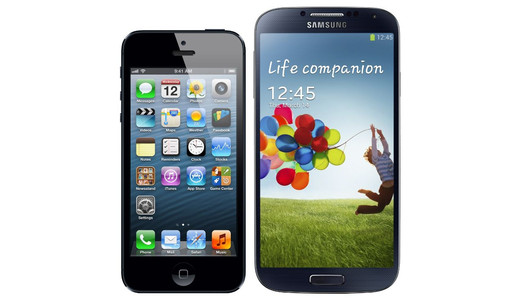When trying to clear a winner between Samsung’s newly unveiled Galaxy S5 and Apple’s iPhone 5S, be sure that there’s no clear answer. Rather, it’s worth taking a look at which features better suit the functionality of the hardware.
Design
Take a look at the following size specs between the GS5 and the iPhone 5S:
- iPhone 5S: 124x59x7.6mm 112g
- Galaxy S5: 142x73x8.1mm 145g
The flagships are varied in size, which leads to physical differences that affect functionality right out of the gate. For instance, the iPhone 5S is, as always, much more thin than the Galaxy S5, but the sheer size of the GS5 offers much more screen real estate in addition to boasting a higher pixel density.
The size increase is much less in this iteration of the Galaxy than has been seen in the past, but it remains that the iPhone 5S is much easier to use single-handedly. All the bulk of the GS5 does not come unwarranted, however.
The size of the GS5 comes with an increase in battery power, a much-discussed feature across the web. Also, the GS5 is dust resistant and virtually waterproof, leaving the iPhone 5S far behind.
Fingerprint Reader
The functionality of the fingerprint readers on both smartphones is very advanced. The advantage held over the GS5 in the technology by the iPhone 5S is the envisioning of the user process.
To scan one’s fingerprint on the GS5 one must slide the specified finger straight down the home button, where the iPhone 5S requires a simple touch to trigger the unlock sequence; perhaps this differentiation will make a big difference when considering the respective sizes of the smartphones as mentioned above, with the iPhone 5S coming off better for the design specs.
The GS5 allows up to eight fingerprints to be identified as opposed to the iPhone 5S’s five. While this may be only a battle of numbers, the GS5 also offers users the ability to, if having assigned a child’s fingerprint, limit the content seen by that assignee, referred to as Easy Mode when used by children.
According to NFC World, the GS5 is paving the way for Near-Field Communication (NFC), and is using its fingerprint scanner to offer payment through PayPal wirelessly. Apple has chosen not to implement this feature, an unsurprising move considering their stance on technologies not yet mature.
Camera
With the unveiling of the GS5, the most prominently talked about feature of the flagship has been the updates to the camera. Retailers/carriers like Verizon Wireless, which first announced the phone, are listing the updates to the camera as unique selling points of the smartphone even before the April 11, 2014, launch. While the differences between the cameras on the GS5 and the iPhone 5S are, in some respects, minute, still they’re creating a buzz web-wide.
The GS5’s camera’s sensor has been increased to 16MP from 13, but an arising issue with the upgrade is the untimely acquisition of the image. The iPhone 5S has an 8MP rear-facing camera and produces beautiful image quality thanks to a two-stage flash that keeps the integrity of the image in any lighting. The question to discuss here is simply the speed one needs in capturing images.
The iPhone 5S offers a Burst mode using which one may take up to 10 photos per second. Samsung has doubled-up efforts on speed and developed an phase-detect autofocus feature, allowing the GS5 to focus on the target in 0.3 seconds, which should increase its speed in image acquisition.
One may forever argue the virtues of one smartphone over another. Ultimately the trend has been that a smartphone is only as good as its cooperation with other smartphones and the wider services provided by user-made and proprietary applications. Consider your own needs in a phone and sum up all potential issues and features before committing, for there’s truly no clear winner here.


